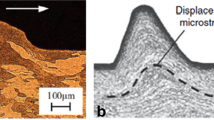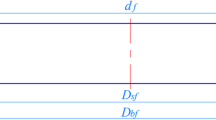Abstract
Groove-section rings, as a kind of profile rings, are widely used in oil and gas pipeline valves, bearings, and aircraft engine casings. According to the geometric feature of groove, they can be divided into symmetrical shallow-groove ring, symmetrical deep-groove ring, and asymmetrical deep-groove ring. In this paper, based on different contact and feed modes during ring rolling, three kinds of rolling methods for the three kinds of groove-section rings are presented, which are named ring rolling with single contact and single feed (RSCSF), ring rolling with multiple contacts and single feed (RMCSF), and ring rolling with multiple contacts and multiple feeds (RMCMF). The above three rolling methods for three different groove-section rings are explored by FE simulation. The geometric accuracy of rolled ring and the material flow behavior during ring rolling are discussed comprehensively. The results show that the RSCSF technology is feasible for symmetrical shallow-groove ring, the RMCSF technology is reasonable for symmetrical deep-groove ring, and the RMCMF technology is suitable for asymmetrical deep-groove ring. Experiment studies on three typical groove-section parts rolled by the above three kinds of rolling methods are performed. The experiment results indicate that the three rolling methods for three kinds of groove-section rings are feasible. This study can provide a reliable guide for precision forming groove-section ring.
Similar content being viewed by others
References
Allwood JM, Tekkaya AE, Stanistreet TF (2005) The development of ring rolling technology. Steel Res 76(2):111–120. https://doi.org/10.1002/srin.200505981
Allwood JM, Tekkaya AE, Stanistreet TF (2005) The development of ring rolling technology – part 2: investigation of process behaviour and production equipment. Steel Res 76(7):491–507. https://doi.org/10.1002/srin.200506044
Hua L, Deng JD, Qian DS (2017) Recent development of ring rolling theory and technique. Int J Mater Prod Technol 54:65–86. https://doi.org/10.1504/IJMPT.2017.080566
Hua L, Zhao ZZ (1997) The extremum parameters in ring rolling. J Mater Process Technol 69(1/3):273–276
Hua L, Pan LB, Lan J (2009) Researches on the ring stiffness condition in radial-axial ring rolling. J Mater Process Technol 209(5):2570–2575. https://doi.org/10.1016/j.jmatprotec.2008.06.002
Hua L, Deng JD, Qian DS, Lan J, Long H (2016) Modeling and application of ring stiffness condition for radial-axial ring rolling. Int J Mach Tool Manu 110:66–79. https://doi.org/10.1016/j.ijmachtools.2016.09.003
Lee KH, Kim BM (2013) Advanced feasible forming condition for reducing ring spreads in radial-axial ring rolling. Int J Mech Sci 76:21–32. https://doi.org/10.1016/j.ijmecsci.2013.08.007
Parvizi A, Abrinia K (2014) A two dimensional upper bound analysis of the ring rolling process with experimental and FEM verifications. Int J Mech Sci 79:176–181. https://doi.org/10.1016/j.ijmecsci.2013.12.012
Berti GA, Quagliato L, Monti M (2015) Set-up of radial-axial ring-rolling process: process worksheet and ring geometry expansion prediction. Int J Mech Sci 99:58–71. https://doi.org/10.1016/j.ijmecsci.2015.05.004
Hua L, Deng JD, Qian DS, Ma Q (2015) Using upper bound solution to analyze force parameters of three-roll cross rolling of rings with small hole and deep groove. Int J Adv Manuf Technol 76(1/4):353–366. https://doi.org/10.1007/s00170-014-6107-x
Allwood JM, Kopp R, Michels D, Music O, Öztop M, Stanistreet TF, Tekkaya AE, Tiedemman I (2005c) The technical and commercial potential of an incremental ring rolling process. CIRP Ann Manuf Technol 54(1):233–236
Ryttberg K, Wedel MK, Recina V, Dahlman P, Nyborg L (2010) The effect of cold ring rolling on the evolution of microstructure and texture in 100Cr6 steel. Mater Sci Eng A 527(9):2431–2436. https://doi.org/10.1016/j.msea.2009.12.016
Guo J, Qian DS, Deng JD (2016) Grain refinement limit during hot radial ring rolling of as-cast GCr15 steel. J Mater Process Technol 231:151–161. https://doi.org/10.1016/j.jmatprotec.2015.12.018
Wang XK, Hua L, Han XH, Wang XX, Wang DH, Liu YL (2014) Numerical simulation and experimental study on geometry variations and process control method of vertical hot ring rolling. Int J Adv Manuf Technol 73(1–4):389–398. https://doi.org/10.1007/s00170-014-5770-2
Qian DS, Hua L, Zuo ZJ (2007) Investigation of distribution of plastic zone in the process of plastic penetration. J Mater Process Technol 187(12):734–737
Anjami N, Basti A (2010) Investigation of rolls size effects on hot ring rolling process by coupled thermo-mechanical 3D-FEA. J Mater Process Technol 210(10):1364–1377. https://doi.org/10.1016/j.jmatprotec.2010.03.026
Wang M, Yang H, Zhang C, Guo LG (2013) Microstructure evolution modeling of titanium alloy large ring in hot ring rolling. Int J Adv Manuf Technol 66(9):1427–1437. https://doi.org/10.1007/s00170-012-4420-9
Schwich G, Henke T, Seitz J (2014) Prediction of microstructure and resulting rolling forces by application of a material model in a hot ring rolling process. Key Eng Mater 622:970–977
Li L, Li X, Liu J, He Z (2013) Modeling and simulation of cold rolling process for double groove ball-section ring. Int J Adv Manuf Technol 69(5–8):1717–1729. https://doi.org/10.1007/s00170-013-5140-5
Zhao YM, Qian DS (2010) Effect of rolling ratio on groove-section profile ring rolling. J Mech Sci Technol 24(8):1679–1687. https://doi.org/10.1007/s12206-010-0525-y
Tani K, Ishigai S, Sato T, Tsumor Y (2005) The evolution of near-net-shape ring-rolling processes for large rings made of Ti-6Al-4V. Kobelco. Technol Rev 26:43–48
Deng JD, Mao HJ (2015) A blank optimization design method for three-roll cross rolling of complex-groove and small-hole ring. Int J Mech Sci 93:218–228. https://doi.org/10.1016/j.ijmecsci.2014.10.024
Zhu X, Liu D, Yang Y (2016) Effects of blank dimension on forming characteristics during conical-section ring rolling of Inco718 alloy. Int J Adv Manuf Technol 84(9):2707–2718. https://doi.org/10.1007/s00170-015-7839-y
Park M, Lee C, Lee J, Lee I, Joun M, Kim B (2016) Development of L-sectioned ring for construction machines by profile ring rolling process. Int J Precis Eng Manuf 17(2):233–240. https://doi.org/10.1007/s12541-016-0030-z
Xu W, Chen F, Guo ZQ, Wang QL, Yang XB (2017) Parametric design of ring billet for profile ring rolling process based on electric field method and feeding strategy design. Int J Adv Manuf Technol 93(1–4):1017–1027. https://doi.org/10.1007/s00170-017-0530-8
Li Q, Ma Z, Liu T, Li F, Wei Z, Su C (2014) 3D thermomechanically coupled FEM analysis of large disk rolling process and trial production. Int J Adv Manuf Technol 74(1–4):403–411. https://doi.org/10.1007/s00170-014-5985-2
Zhou P, Zhang L, Gu S, Ruan J, Teng L (2014) Mathematic modeling and FE simulation of radial-axial ring rolling large L-section ring by shape axial roll. Int J Adv Manuf Technol 72(5–8):729–738. https://doi.org/10.1007/s00170-014-5705-y
Alfozan A, Gunasekera JS (2002) Design of profile ring rolling by backward simulation using upper bound element technique (UBET). J Manuf Process 4(2):97–108. https://doi.org/10.1016/S1526-6125(02)70136-9
Tiedemann I, Hirt G, Kopp R, Michl D, Khanjari N (2007) Material flow determination for radial flexible profile ring rolling. Prod Eng 1(3):227–232. https://doi.org/10.1007/s11740-007-0030-z
Lee KH, Ko DC, Kim DH, Lee SB, Sung NM, Kim BM (2014) Design method for intermediate roll in multi-stage profile ring rolling process: the case for excavator idler rim. Int J Precis Eng Manuf 15(3):503–512. https://doi.org/10.1007/s12541-014-0364-3
Qian DS, Zhang ZQ, Hua L (2013) An advanced manufacturing method for thick-wall and deep-groove ring-combined ring rolling. J Mater Process Technol 213(8):1258–1267. https://doi.org/10.1016/j.jmatprotec.2013.01.024
Wang M, Li X, Du F (2004) Hot deformation of austenite and prediction of microstructure evolution of cross-wedge rolling. Mater Sci Eng A 379(1/2):133–140. https://doi.org/10.1016/j.msea.2004.01.055
Acknowledgements
The authors would like to thank the National Natural Science Foundation of China (No.51575414) and the grant from the high-end Talent Leading Program of Hubei province (No.2012-86), a Key R&D Program of Jiangsu province (BE2016009).
Author information
Authors and Affiliations
Corresponding author
Rights and permissions
About this article
Cite this article
Qian, D., Deng, J. & He, S. Precision rolling methods for groove-section ring based on different contact and feed mode. Int J Adv Manuf Technol 95, 3953–3968 (2018). https://doi.org/10.1007/s00170-017-1512-6
Received:
Accepted:
Published:
Issue Date:
DOI: https://doi.org/10.1007/s00170-017-1512-6




